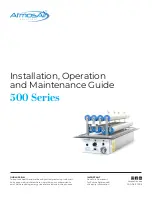
Installation, Operation & Maintenance Guide
500 Series
9
1-888-MY-AIR11 CAG-06-21-003 AtmosAir.com
04
OPERATION
Once the system is properly installed and all personnel are
clear of the high voltage tubes, the system can be turned on:
1.
Ensure the ionization power knob is turned all the way
counterclockwise in the ‘off’ position.
2.
Flip the power switch up to the ‘on’ position. The green
embedded LED light above the power switch should light
up to indicate that the power is on and running to the
system.
3.
Set the ionization power knob to the appropriate setting
(1-5, with 1 being low and 5 being high). The red embedded
LED above the power knob should light up to indicate that
ionization has been activated and high voltage is being
sent to the tubes’ electrodes. An initial ion level setting of
#3 is recommended.
05
MAINTENANCE
REQUIREMENTS
■
The maintenance requirements on an AtmosAir system are
mainly site-dependent; a heavily contaminated environment
may require more frequent inspection & maintenance. In
general, a semi-annual inspection is recommended along
with a bi- annual tube replacement.
■
The local AtmosAir dealer can provide you with an annual
service contract.
Inspection:
■
Visually check the performance of the system by checking the
red and green lights on the individual units. If both lights are on,
and you can hear the ‘buzz’ of the tubes, then unit is functioning
properly. If not, proceed to the troubleshooting section for repair.
Maintain a physical distance between all personnel and the
tubes while system is operating or turned on.
!!!WARNING!!!
A non-functioning LED light may improperly indicate that the system
is not functioning. Be sure to disconnect from the mains power before
performing maintenance or troubleshooting the system.
■
Optional:
Check performance using a high voltage probe
(minimum of 5000 V, Contact AtmosAir for additional minimum
probe specifications) paired with a multimeter. Follow proper
safety procedures for dealing with high voltages. If you are
uncertain, do NOT perform any maintenance with the power on
and, instead, proceed to the next step.
■
Disconnect the system from the mains power before
performing any maintenance steps.
■
Inspect the unit box, plastic tube caps, and tube-mounting
plate. Remove any stains, dirt or debris using ordinary
household cleaner from mounting plate, and thoroughly wipe
clean any tracks or grooves that may have developed in the
plate or caps.
■
Inspect connections: tightness of all nuts and screws; remove
deposits on the connections using sandpaper or wire brush - it
may be necessary to remove the tubes for this step.
■ It may be beneficial to clean the tubes to improve performance.
The tubes can be cleaned using an air compressor for a quick
clean, or more thoroughly with cleaning solutions. Do not
immerse the tubes in water. Ensure that the tubes and mesh
and all components are completely dry before re-installing.
■
When replacing tubes, be sure not to over-tighten the loop
connector. Do not use a power driver, please
only use a hand
Phillips head screwdriver
to tighten the loop connector and
be sure
not
to over tighten. For the retaining nut on the back
end of tube, only use a hand held nut driver, and tighten this nut
snugly.
Tube Replacements:
Bi-annual tube inspections are recommended, in addition to
tube replacements once every two years as the production
efficiency slowly declines over time due to the stress caused
by plasma and (lack of) cleanliness of the electrodes. Old
or excessively dirty tubes can also put undue stress on the
transformer causing premature failure.






























